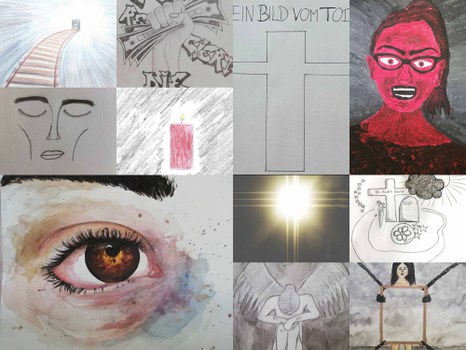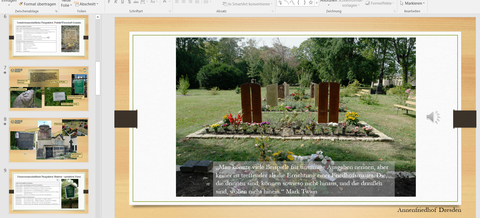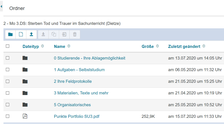Sterben, Tod und Trauer im Sachunterricht: Isabell Dietze-Fründt (#ID1)
Format
Seminar, 100% asynchron
Schlagworte
Friedhof, Sachunterricht, Philosophieren, Erfahrungsschätze, Nachdenklichkeit

© Isabell Dietze-Fründt

© Isabell Dietze-Fründt

© Isabell Dietze-Fründt

© Isabell Dietze-Fründt

© Isabell Dietze-Fründt

© Isabell Dietze-Fründt

© Isabell Dietze-Fründt
Beschreibung
Sterben, Tod und Trauer – das ist doch nichts für Kinder!
Vorerst scheint es nicht zum Grundschulalltag bzw. zum Sachunterricht zu gehören. Schnell sind ablehnende Aussagen zu beobachten. Diese Auffassung ist jedoch nicht aktuell und oft müssen Lehrkräfte spontan und plötzlich mit den Sorgen der Kinder dann agieren, wenn beispielsweise die Oma nicht mehr da ist, das Haustier nie wiederkommt und die Kinder verständlicherweise Antworten auf unzählige Fragen wollen: Was passiert nach dem Tod? Tut Sterben weh? Wieso leben wir nicht ewig?
In der Sachunterrichtsdidaktik sind Kinderfragen ein zentrales Element und beweisen, wie vielfältig und kreativ ein einzelnes Thema behandelt werden kann. Vorerst ist es jedoch genauso wichtig, dass man sich selbst mit der vermeintlich unangenehmen Sache konfrontiert und behutsam erkundet, was man selbst denkt und fühlt, welche Fragen man hat und wie das eigene Bild vom Tod aussieht ehe man pädagogische Arbeit leistet.
Im Seminar haben wir das Potential des außerschulischen Lernorts Friedhof nicht nur im Hinblick auf historische und sozialwissenschaftliche Fragen erkundet, sondern auch wie Medien, Bildung für nachhaltige Entwicklung und Mobilität mit diesem Lernort verknüpft werden können. Methoden, die noch „neu“ sind wie z.B. das Philosophieren mit Kindern, und viele weitere Wege wurden analysiert, um zukünftigen Klassen Tod und Trauer verständlich zu machen.
Um digital diskutieren zu können, habe ich mehrere Formen genutzt: ein Matrix-Chat erleichterte das schnelle Organisieren, Nextcloud und OPAL bildeten das Gerüst, für Inhalte, Padlets waren neue Diskussionsplattformen, PowerPoint mit oder ohne Ton sowie YouTube-Videos waren die neuen Referate und mittels Edkimo wurde evaluiert. Wir waren dankbar, dass im Sommersemester alle Friedhöfe geöffnet blieben, sodass jeder für sich seine persönlichen Erfahrungen und Exkursion zu diesem besonderen Lernort machen konnte. Ein Portfolio als Prüfungsleistung fasste alle Gedanken des Lernprozesses zusammen und bot einen sensiblen Einblick in jede Lerngeschichte der einzelnen Teilnehmerinnen und Teilnehmer.
Ansprechpartner
Abstimmungskennung
#ID1







